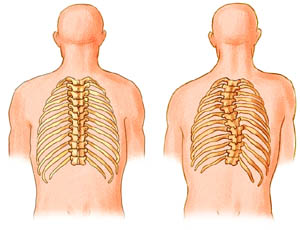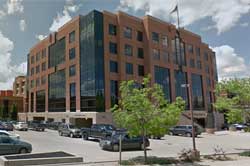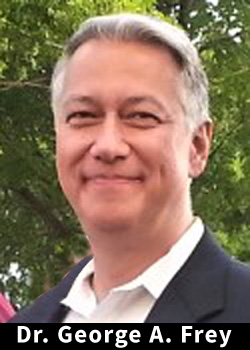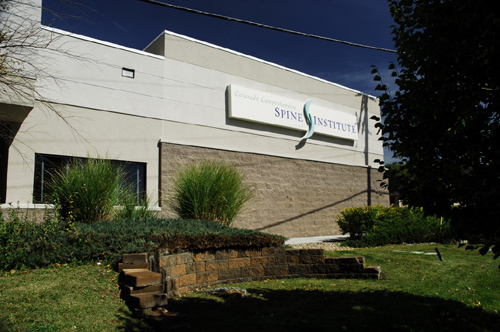Locations

Fax: (303) 762-9292

Explaining Spinal Disorders: Adult Degenerative Scoliosis
Scoliosis, or abnormal curvature of the spine, is often only associated with adolescents. However, adults can have scoliosis too. Adult scoliosis is defined as abnormal curvature of the spine in a patient over the age of 18. Sometimes adult scoliosis results from untreated childhood curvature that has progressed. When scoliosis develops during adulthood, without a history of childhood curvature, it is usually classified as adult degenerative scoliosis.
 Normal spine (left) - Scoliosis (right)
Normal spine (left) - Scoliosis (right)
Symptoms
As we age, our bodies change. When parts of the vertebral column begin to age, some people begin to experience back or neck pain. Common degenerative spinal conditions include:
- Spinal stenosis
- Degenerative disc disease
- Osteoporosis
- Vertebral compression fractures
Sometimes, the effects of these conditions cause the spine to curve to the left or right. Abnormal curvature can cause problems such as:
- Trunk imbalance, making the patient appear as though listing to one side
- Spinal instability
- Rib prominence on either side
- Humpback
- A collapsing feeling, or falling forward
- Irregular gait caused by a discrepancy in leg length
- Progressive pain in the back, flanks (area between the ribs and hips), buttocks, and legs
- Difficulty sitting or standing with rapid fatigue
- Spinal rigidity and stiffness
- Nerve damage
- Cardiopulmonary (heart and lung) problems
Diagnosis
Our practice combines your medication history, physical examination and advanced diagnostic technologies to make an accurate diagnosis.
- Medical history. We discuss your symptoms, their severity, and treatments you have already tried. We want to know about a history of scoliosis in your family.
- Physical examination. Your physical examination includes a neurological exam too. During this comprehensive examination, we evaluate movement limitations, balance problems, pain, extremity reflexes, muscle weakness, sensation, and other matters related to your health. Part of your exam may include a series of movements such as bending sideways, forward and backward at the waist, and walking. The doctor may measure your legs to see if there is any difference in length.
- Diagnostic tests. Generally, we start with standing x-rays, taken from the front and the side. Side bending x-rays are sometimes helpful to evaluate spinal flexibility. In addition, if necessary, a CT scan, MRI, or myelography is performed, especially when leg symptoms of nerve compression are present.
Front view (anterior-posterior, AP) of severe lumbar (low back) Adult Degenerative Scoliosis. Note the dense bone degeneration, disc space collapse, and vertebral shifting. This patient has severe stenosis, back and leg pain.
Treatment
Most cases of adult scoliosis are treated without surgery. Treatment may include:
- No treatment; observe the curve for possible progression
- Pain and anti-inflammatory medications
- Back exercises for posture and strength
- Moist heat
- In some cases, bracing may be used (but only to control pain, not to correct the deformity)
Surgical correction of adult degenerative scoliosis is uncommon. However, it may be necessary if:
- Nonoperative treatment fails and pain persists or worsens
- Curvature is progressive or excessive (curves greater than 30-degrees)
- Progressive nerve involvement; pain, numbness, weakness
- Curvature causes cardiopulmonary problems (heart, lung)
If spine surgery is necessary, it may include spinal instrumentation with fusion. Instrumentation (i.e. rods, screws) and fusion (bone graft) joins two or more vertebrae and stabilizes the spine. Be assured that if surgery is necessary, all aspects of the procedure, including risks and benefits, will be fully explained to you.
Keep in mind that many cases of adult degenerative scoliosis need no treatment at all. However, it is important to maintain good general and spine health. This includes regular exercise to be strong and flexible, good body mechanics, sensible eating and healthy weight maintenance, and no smoking. Our therapists are experts at helping you to develop healthy habits.









